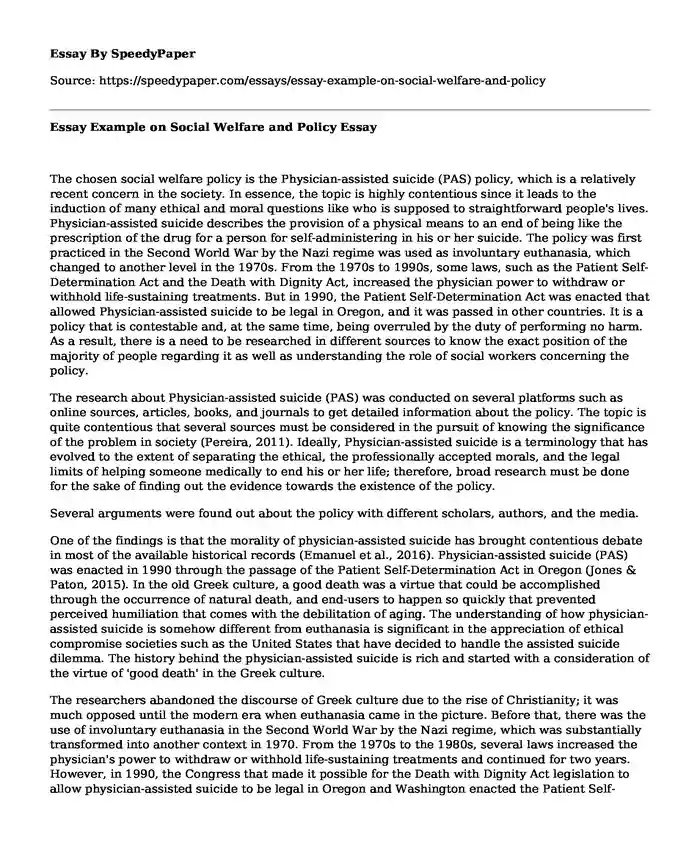
| Type of paper: | Essay |
| Categories: | Healthcare policy Public health |
| Pages: | 3 |
| Wordcount: | 731 words |
The chosen social welfare policy is the Physician-assisted suicide (PAS) policy, which is a relatively recent concern in the society. In essence, the topic is highly contentious since it leads to the induction of many ethical and moral questions like who is supposed to straightforward people's lives. Physician-assisted suicide describes the provision of a physical means to an end of being like the prescription of the drug for a person for self-administering in his or her suicide. The policy was first practiced in the Second World War by the Nazi regime was used as involuntary euthanasia, which changed to another level in the 1970s. From the 1970s to 1990s, some laws, such as the Patient Self-Determination Act and the Death with Dignity Act, increased the physician power to withdraw or withhold life-sustaining treatments. But in 1990, the Patient Self-Determination Act was enacted that allowed Physician-assisted suicide to be legal in Oregon, and it was passed in other countries. It is a policy that is contestable and, at the same time, being overruled by the duty of performing no harm. As a result, there is a need to be researched in different sources to know the exact position of the majority of people regarding it as well as understanding the role of social workers concerning the policy.
The research about Physician-assisted suicide (PAS) was conducted on several platforms such as online sources, articles, books, and journals to get detailed information about the policy. The topic is quite contentious that several sources must be considered in the pursuit of knowing the significance of the problem in society (Pereira, 2011). Ideally, Physician-assisted suicide is a terminology that has evolved to the extent of separating the ethical, the professionally accepted morals, and the legal limits of helping someone medically to end his or her life; therefore, broad research must be done for the sake of finding out the evidence towards the existence of the policy.
Several arguments were found out about the policy with different scholars, authors, and the media.
One of the findings is that the morality of physician-assisted suicide has brought contentious debate in most of the available historical records (Emanuel et al., 2016). Physician-assisted suicide (PAS) was enacted in 1990 through the passage of the Patient Self-Determination Act in Oregon (Jones & Paton, 2015). In the old Greek culture, a good death was a virtue that could be accomplished through the occurrence of natural death, and end-users to happen so quickly that prevented perceived humiliation that comes with the debilitation of aging. The understanding of how physician-assisted suicide is somehow different from euthanasia is significant in the appreciation of ethical compromise societies such as the United States that have decided to handle the assisted suicide dilemma. The history behind the physician-assisted suicide is rich and started with a consideration of the virtue of 'good death' in the Greek culture.
The researchers abandoned the discourse of Greek culture due to the rise of Christianity; it was much opposed until the modern era when euthanasia came in the picture. Before that, there was the use of involuntary euthanasia in the Second World War by the Nazi regime, which was substantially transformed into another context in 1970. From the 1970s to the 1980s, several laws increased the physician's power to withdraw or withhold life-sustaining treatments and continued for two years. However, in 1990, the Congress that made it possible for the Death with Dignity Act legislation to allow physician-assisted suicide to be legal in Oregon and Washington enacted the Patient Self-Determination Act.
Conclusion
In summary, the policy is not responsible for oppressing any particular groups but could be applied to all patients regardless of discrimination. Indeed, the system does not apply in the protection of any specific groups in the society because it is entirely used in the health care facilities and done under confidential procedures that known to close family members. The only movement that tries the policy is the Future of the Right-to-Die Movement, where the majority of doctors are opposing physician-assisted suicide.
References
Emanuel, E. J., Onwuteaka-Philipsen, B. D., Urwin, J. W., & Cohen, J. (2016). Attitudes and practices of euthanasia and physician-assisted suicide in the United States, Canada, and Europe. Jama, 316(1), 79-90.
Jones, D. A., & Paton, D. (2015). How does legalization of physician assisted suicide affect rates of suicide? Southern medical journal, 180(10), 599-604.
Pereira, J. (2011). Legalizing euthanasia or assisted suicide: the illusion of safeguards and controls. Current Oncology, 18(2), e38.
Cite this page
Essay Example on Social Welfare and Policy. (2023, Apr 30). Retrieved from https://speedypaper.net/essays/essay-example-on-social-welfare-and-policy
Request Removal
If you are the original author of this essay and no longer wish to have it published on the SpeedyPaper website, please click below to request its removal:
- Essay Example: Exploring the Library
- Free Essay Example on Asthma Camps
- Business and Finance Essay Example
- Literary Essay Sample on a Trilogy The Lord of the Rings by J. R. R. Tolkien
- Free Paper with Questions and Answers on Organizational Behaviour and Development
- Essay Sample on Utilizing Frames and Key Messages
- EDs: Social Pressure & Mental Illness - Anorexia & Bulimia: Paper Example
Popular categories




